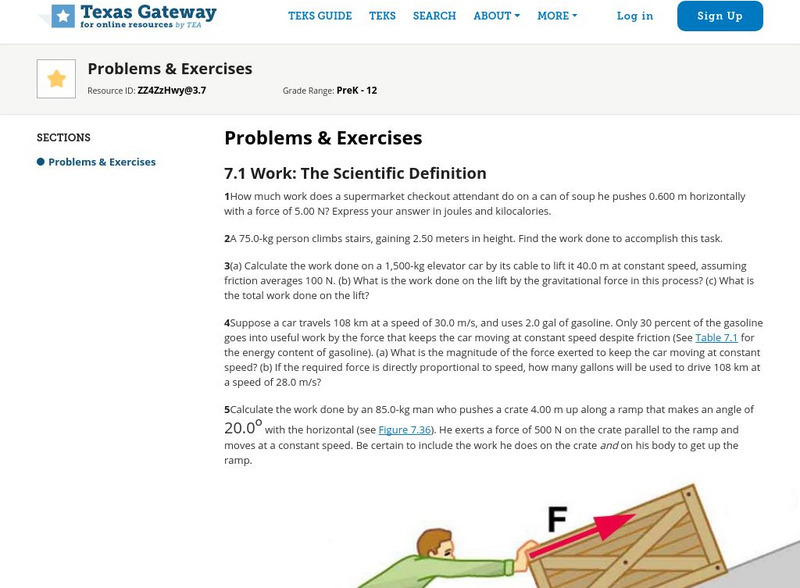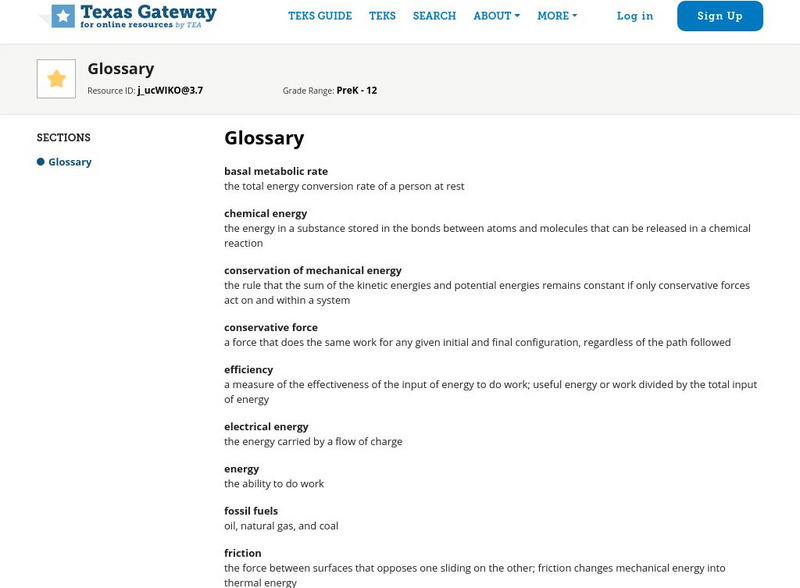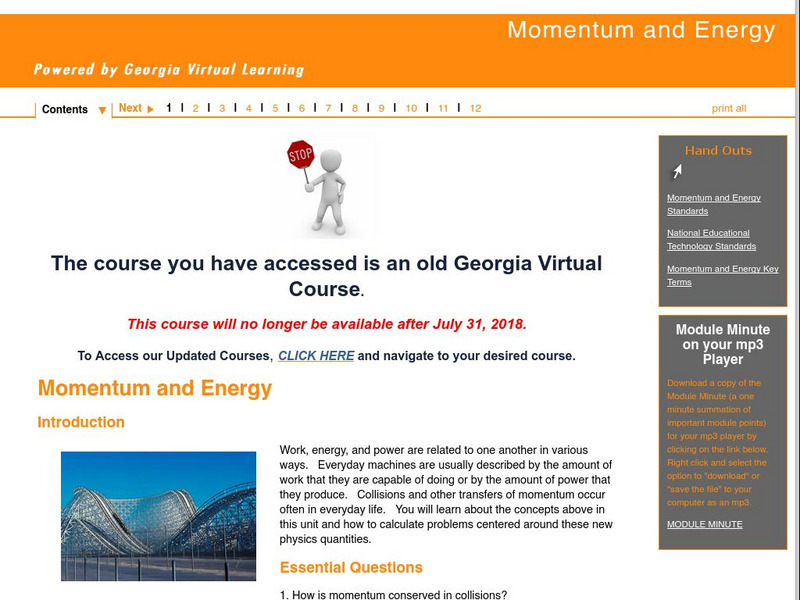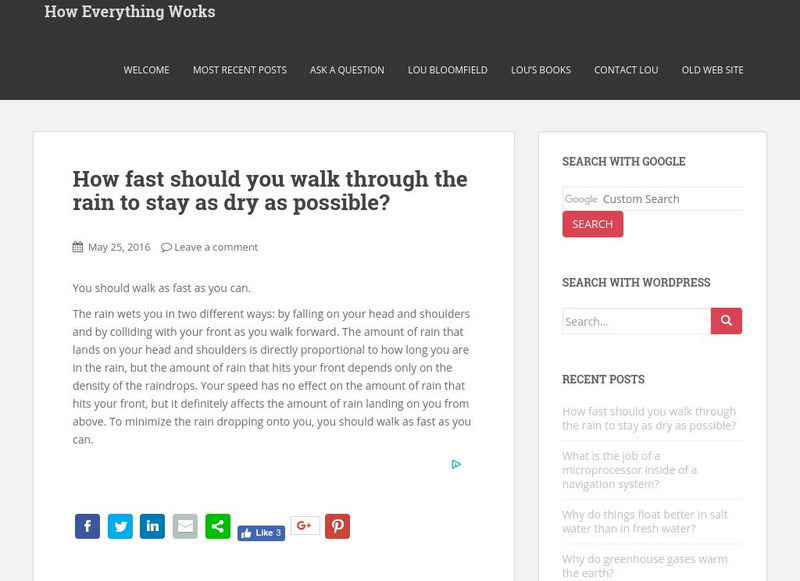OpenStax
Open Stax: Kinetic Energy and the Work Energy Theorem
In the following interactive students will begin to explain work as a transfer of energy and net work as the work done by the net force. They will also explain and apply the work-energy theorem.
Texas Education Agency
Texas Gateway: Work, Energy, and Energy Resources: Summary
This is a summary of the information in Chapter 7: Work, Energy, and Energy Resources for the AP Physics I course online.
Texas Education Agency
Texas Gateway: Work, Energy, and Energy Resources: Problems & Exercises
This is a list of 74 problems/exercises to solve over the content of Chapter 7: Work, Energy, and Energy Resources from the AP Physics online text.
Texas Education Agency
Texas Gateway: Work, Energy, and Energy Resources: Conceptual Questions
This page provides a list of 26 questions covering the major concepts in Chapter 7: Work, Energy, and Energy Resources from the AP Physics online text.
Texas Education Agency
Texas Gateway: Work, Energy, and Energy Resources: Glossary
This is a glossary of words and definitions of terms having to do with work, energy, and energy resources.
OpenStax
Open Stax: Work, Energy, and Power in Humans
In the following interactive students will begin to explain the human body's consumption of energy when at rest vs. when engaged in activities that do useful work. They will also calculate the conversion of chemical energy in food into...
Texas Education Agency
Texas Gateway: Kinetic Energy and the Work Energy Theorem
By the end of this section, you will be able to explain work as a transfer of energy and net work as the work done by the net force and to explain and apply the work-energy theorem.
Georgia Department of Education
Ga Virtual Learning: Ap Physics 1: Work, Energy, and Power
The mathematical model for the relationships between work and energy serves to model physical problems and, more importantly, predict natural and man-made phenomena. Students discover the relationships which serve as a powerful...
OpenStax
Open Stax: Potential Energy and Conservative Forces
In the following interactive students will define conservative force, potential energy, and mechanical energy. They will explain the potential energy of a spring in terms of its compression when Hooke's Law applies. Students will also...
Physics Classroom
The Physics Classroom: The Work Energy Theorem
This page explores the quantitative relationship between work and mechanical energy in situations in which there are no external forces doing work. It is a basic analysis of situations in which mechanical energy is conserved. Examples...
Texas Education Agency
Texas Gateway: Work, Energy, and Power in Humans
By the end of this section, you will be able to explain the human body's consumption of energy when at rest versus when engaged in activities that do useful work and to calculate the conversion of chemical energy in food into useful work.
Physics Classroom
The Physics Classroom: Work, Energy, and Power: Calculating Work Done by Forces
Through interactive practice problems and examples, students calculate the amount of work done by forces.
Physics Classroom
The Physics Classroom: Work, Energy, and Power: Definition/mathematics of Work
Through examples and interactive practice problems, motion will be approached from the perspective of work and energy.
Physics Classroom
The Physics Classroom: Work, Energy, and Power: Potential Energy
This introduction to potential energy contains illustrated examples, example problems, and interactive exercises for application of learning.
Physics Classroom
The Physics Classroom: Work, Energy, and Power: Kinetic Energy
Introduce students to the concept of kinetic energy through interactive practice exercises and illustrated examples.
Physics Classroom
The Physics Classroom: Work, Energy, and Power: Mechanical Energy
Introduce students to the concept of mechanical energy through interactive practice exercises and illustrated examples.
Texas Education Agency
Texas Gateway: Ap Physics: Conservative Forces and Potential Energy
By the end of this section, you will be able to define conservative force, potential energy, and mechanical energy; explain the potential energy of a spring in terms of its compression when Hooke's law applies; and use the work-energy...
CK-12 Foundation
Ck 12 Exploration Series: Simulations: Physics: Block and Tackle
[Free Registration/Login Required] A video module where students learn about the relationship between force, work, energy, and mechanical advantage using a simple machine.
Georgia Department of Education
Ga Virtual Learning: Momentum and Energy
In this module, students learn how work, energy, and power are related to one another in various ways. They also learn about collisions and the conservation of momentum.
Texas Education Agency
Texas Gateway: Rotational Kinetic Energy: Work and Energy Revisited
By the end of this section, you will be able to derive the equation for rotational work, calculate rotational kinetic energy, and demonstrate the law of conservation of energy.
University of New South Wales (Australia)
University of New South Wales: School of Physics: Physclips: Energy and Power
Learn about energy and power in this learning module that contains videos and animation.
Other
University of Virginia: How Things Work
A site maintained by A. Bloomfield, the author of "How Things Work: The Physics of Everyday Life." You can read old questions or ask Bloomfield your own. Great explanations of everyday physics.
Physics Classroom
The Physics Classroom: Work, Energy, and Power: Power
In this interactive module, students learn the basic terminology and concepts of power as it has to do with work and energy.
Physics Classroom
The Physics Classroom: Work, Energy, and Power: Mechanical Energy Is Conserved
In this interactive exercise, explore the quantitative relationship between work and mechanical energy in situations in which there are no external forces doing work.















